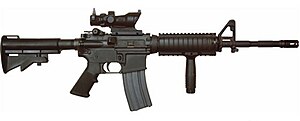Karabin M4, atau M4 Carbine, adalah versi pendek dan ringan dari senapan serbu M16. Karabin M4 memiliki 80% bagian yang sama dengan M16A2. M4 memiki pilihan tembakan semi-otomatis dan burst tiga butir (sama dengan M16A2), sedangkan M4A1 memiliki pilihan semi-otomatis dan otomatis. M4A1 juga terkadang dilengkapi laras yang lebih berat, untuk menahan panas yang dihasilkan dari menembak otomatis untuk waktu yang lama.
| M4 Carbine | |
|---|---|
 M4A1 dengan bidikan ACOG dan pegangan depan vertikal. | |
| Tipe | Senapan serbu |
| Negara asal | Amerika Serikat |
| Sejarah pemakaian | |
| Digunakan | 1994— |
| Pemakai | NATO, Malaysia, Israel, Indonesia, Filipina, Australia dan banyak sekali lainnya |
| Sejarah produksi | |
| Diproduksi | 1994— |
| Varian | M4A1, CQBR |
| Spesifikasi | |
| Berat | 2,52 kg kosong; 3,0 kg dengan isi 30-butir peluru |
| Panjang | 757 mm (29,8 in) popor masuk; 838 mm (33 in) popor keluar |
| Panjang laras | 368,3 mm (14,5 in) |
| | |
| Peluru | 5.56 x 45 mm NATO |
| Kaliber | 5.56 mm (.223 in) |
| Mekanisme | operasi gas, bolt berputar |
| Kec. tembak | 700–950 butir/menit |
| Kec. peluru | 905 m/s (2.970 ft/s) |
| Jarak efektif | 300 m |
| Jarak maksimum | 800 m |
| Pengisian | Magazen box 50 atau 150-butir [Magazen] ganda 250 atau 750-butir |
Garis besar

M4 dan M4A1 menggunakan peluru kaliber 5.56 x 45 mm NATO. Keduanya adalah senapan selective-fire, yang menggunakan sistem gas, air-cooled, memakai magazen box, dan mempunyai popor teleskopik. Popor ini bisa ditukar dengan popor biasa, tapi itu jarang dilakukan pada militer Amerika Serikat.
Seperti karabin pada umumnya, M4 lebih nyaman ditenteng daripada senapan laras panjang. Selain ideal untuk digunakan oleh tentara non-infanteri (seperti pengemudi kendaraan, ajudan, dan perwira staf), ini juga membuat M4 cocok untuk pertempuran jarak dekat dan operasi pasukan khusus. M4 sempat menjadi standar untuk United States Special Operations Command (USSOCOM) dan menjadi pilihan Pasukan Khusus Angkatan Darat Amerika Serikat. Pada tahun 2006 Malaysia juga membeli Karabin M4 untuk menggantikan senapan Steyr AUG.
Karabin M4 dikembangkan dan diproduksi untuk Pemerintah Amerika Serikat oleh perusahaan senjata Colt, yang mempunyai kontrak untuk memproduksi keluarga karabin M4 sampai tahun 2009. Tetapi selain Colt, sejumlah produsen senjata lain juga menawarkan senapan yang serupa dengan M4. M4 dan M16A4 sudah menggantikan M16 dan M16A2 pada angkatan bersenjata Amerika Serikat. M4 juga menggantikan submachine gun M3A1 yang biasa dipakai pengendara tank. M4 hampir serupa dengan versi kompak M16 sebelumnya, yaitu XM177, bedanya adalah M4 tidak menggunakan peluru M193/6 ball.
Sejarah dan varian
Selain pada pengiriman pertama, semua M4 dan M4A1 baru yang ada pada militer Amerika Serikat sudah memakai receiver atas yang datar (flat-top) yang dilengkapi railing standar M1913 atau Picatinny rail, yang digunakan untuk memasang berbagai macam alat bidik. Nomor model yang digunakan oleh militer Amerika Serikat adalah Colt Model 920 (M4) dan 921 (M4A1).
M4 MWS (Modular Weapon System)
M4 MWS adalah karabin Colt Model 923 yang dipasang Sistem Railing Aksesori (RAS - Rail Accesory System) buatan perusahaan senjata Knight's Armament Corporation. Senapan ini sebelumnya diberi nama M4E2, tapi penamaan ini dibatalkan, dan M4 yang dipasang sistem ini diberi nama M4 MWS atau Modular Weapon System.
M4A1
Karabin M4A1 adalah modifikasi dari karabin M4, yang dibuat untuk dipakai oleh pasukan khusus. M4A1 banyak dipakai pada pasukan khusus AS, seperti Delta Force, Navy SEALS, dan Force Reconnaissance. Senapan ini menjadi pilihan pasukan khusus dan pasukan anti-teroris, karena ukurannya dan kemampuannya menembak full-otomatis. Fitur-fitur ini sangat berguna untuk pertempuran dalam perkotaan. Walaupun M4A1 tidak memiliki jangkauan tembak sejauh senapan M16, banyak pengamat militer yang berpendapat bahwa menembak target diatas 300 meter tanpa senapan khusus itu tidak perlu. M4A1 sangat efektif pada jarak 150 meter.
SOPMOD Blok I
USSOCOM mengembangkan perangkat Modifikasi Khusus Operasi Khusus (SOPMOD - Special Operations Peculiar Modification) Blok I untuk digunakan pasukan yang ada dibawah kepemimpinannya. Perangkat ini meliputi, antara lain, karabin M4A1, Sistem Railing Antar-muka (RIS - Rail Interface System) buatan Knight's Armament Company (KAC), pelontar granat M203 beserta bidikannya, peredam suara buatan KAC, bidikan cadangan buatan KAC, penunjuk laser/infra-merah AN/PEQ-2A buatan Insight Technologies, bidikan optik ACOG dan Reflex buatan Trijicon, serta sebuah bidikan night vision.
SOPMOD Blok II
Generasi ke-2 SOPMOD sedang direncanakan, dengan banyak perusahaan yang bersaing untuk mendapakan kontraknya. Beberapa perusahaan ternama, beserta rancangan mereka misalnya, Knight's Armament Company dengan URX II, ARMS dengan sistem Selective Integrated Rail (SIR), serta Lewis Machine & Tool dengan Monolithic Rail Platform (MRP).
Varian-varian lain
Varian lain karabin M4 juga dibuat oleh produsen lain, dan dipakai oleh pasukan khusus negara selain Amerika Serikat, antara lain Special Air Service Regiment (SASR) Australia, Pasukan Gerakan Khas Polis Diraja Malaysia, dan Detasemen 88 Anti-teror Polri. Selain itu, SAS Inggris menggunakan juga M4 buatan Diemaco yang diberi nama C8. Walau akhirnya Diemaco dibeli oleh Colt, dan diberi nama Colt Canada, nama-nama senapan versi Diemaco tidak diubah.



